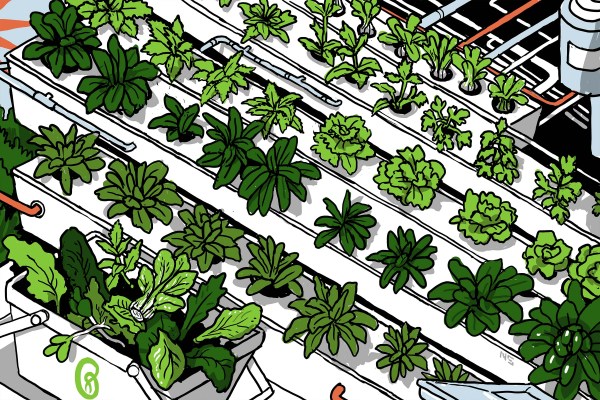“The first thing you notice is just the smell,” chief science officer of Bowery Farming Henry Sztul says excitedly. “It’s got that smell, right?”
There’s a kind of visceral sense memory that hits you as you enter Farm Zero, a Proustian moment that overtakes the senses after years of living in a major city. It smells like greenhouses and grow rooms: fresh, alive and a dramatic contrast from the world immediately outside the building here in Kearny, New Jersey.
Years of indoor farming breakthroughs have made it possible for leafy greens to be grown at larger and larger scales — and, eventually, at a profit.
As I walk through Bowery Farming’s three active vertical farm and research facilities, my mind is teeming with questions about climate change and the potential of sustainable vertical farming. Yet, when it comes right down to it, it’s the taste and, yes, that smell that will drive the company’s — and the industry’s — success.
We’re decked out in clean room coveralls and hairnets. Watches and jewelry are off, the soles of our shoes still damp from standing in sanitizing solution. “In here, we have a fully enclosed environment,” Sztul continues. “We control temperature, humidity, CO2, water flow, nutrients, light levels. When I say light levels I mean the color of the light spectrum, the intensity of the light, the photo period, the day/night cycles.”
Unlike traditional software products, inventing produce is an entirely different endeavor. Perturbations in the inputs of Bowery’s vertical farm can lead to radically different flavor profiles in the leafy greens it distributes.
In the second part of this TC-1, I’ll look at how the company experiments in Farm Zero and what it dubs Farm X, how it develops new produce lines as it expands outside of leafy greens and how it transforms farm work for the urban 21st century while scaling up at its newer Farm One production facility.
Tilling concrete
The smell is the first sense to hit, but it’s the visual that really grabs you. Right in front of me are the grow systems that give vertical farming its name. It’s a kind of scaffolding setup with row atop row of leafy greens nestled in long trays and lit by bright LEDs. PVC piping snakes up and down, delivering the water that cycles through the systems — saving 15 to 20 million gallons of water per farm over traditional growing each year, according to the company’s estimates.
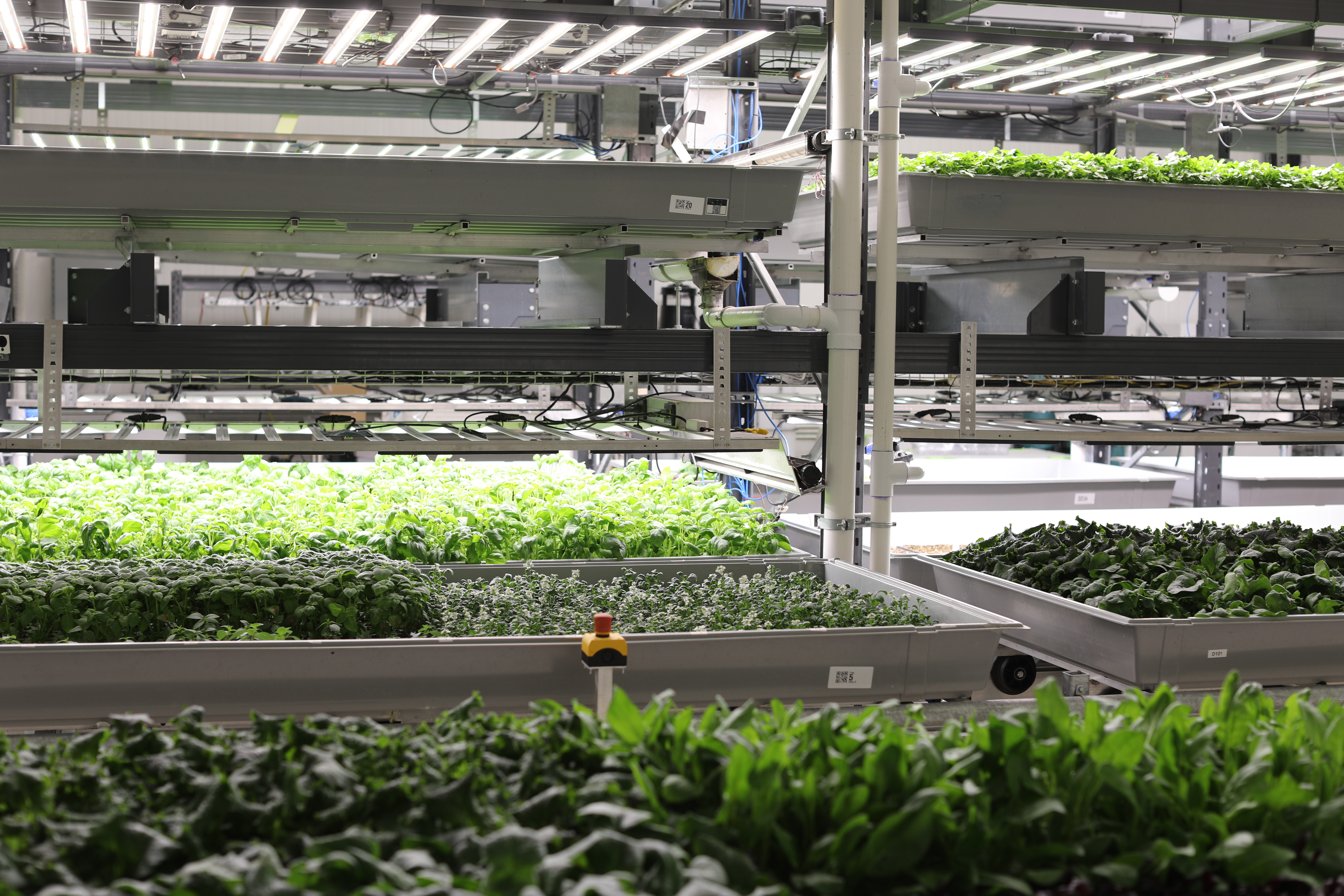
Grow trays bask in light at Bowery Farming. Image Credits: Brian Heater
This entire room is part of one closed irrigation system, circulating the nutrient-rich liquid to all the plants. Bowery says that even the water lost from natural plant perspiration can be captured with its HVAC system and recirculated back into the loop.
The glowing lights are a stark contrast to the gloomy industrial park outside, but even indoors, the visual is somewhat difficult to reconcile. The little pods of bright green vegetation exist in almost a laboratory setting, a strange juxtaposition of the natural and the synthetic that speaks to the heart of what vertical farming attempts to do — effectively hacking 10,000 years of agricultural knowledge.
Seeds are planted in trays with QR codes on the side. Once scanned, Bowery’s software is able to track the contents throughout their life cycle. Lights are trained on the planter and fan speeds are adjusted for precise control over temperature and humidity for any given crop.
“On the top right, right behind the lights, is an aluminum box with a black piece of tape,” Sztul says, pointing to a system. “In that are custom-built control boards, and so what we built is this totally distributed controlling sensing system.”

Bowery Farming chief science officer Henry Sztul. Image Credits: Bowery Farming
That system can detect each individual crop. “When tray 19 has butterhead [lettuce] right there, the lights [and] fans are all set specifically for that butterhead. And when we harvest it and we put in a kale tomorrow, the lights will automatically adjust to that kale based on the fact that we know it’s kale.”
The industry’s youth means one can’t go down to a vertical farming store and buy all of the necessary elements. Farm Zero is where much of Bowery’s trial and error has unfolded since its founding in 2015. They’ve MacGyvered together a system based on farming equipment and components like off-the-shelf microcontrollers to build the foundation of what is now a $2.3 billion company.
A taste of one’s own hacking
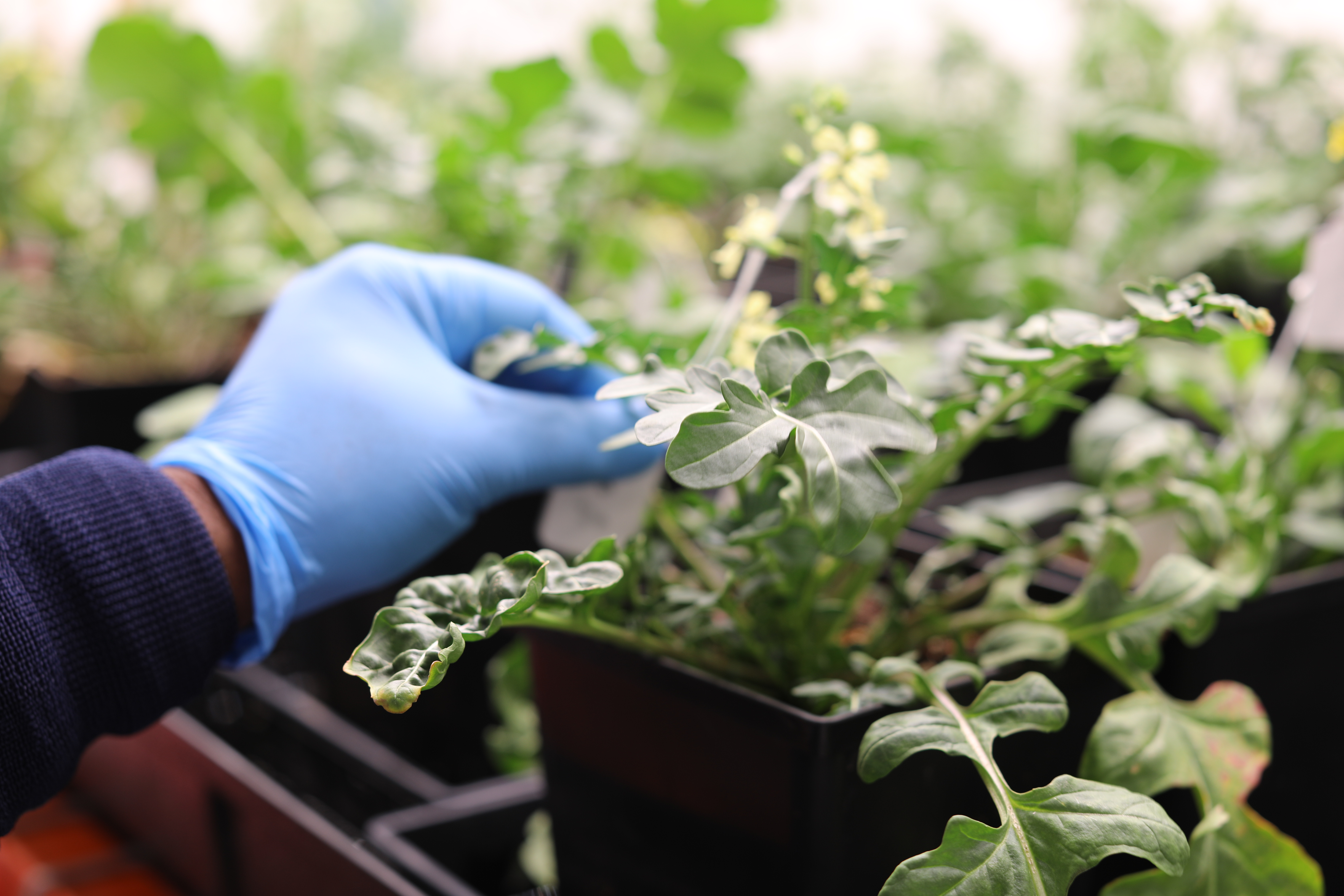
Picking greens from the vine. Image Credits: Brian Heater
Sztul walks up to a tray overflowing with long, green leaves covered in small flowers. He grabs a pair of surgical gloves and scissors, snipping off a leaf. He drops it in my hand and motions for me to taste.
It’s good. Certainly the freshest arugula I’ve ever tasted, spicy and fresh off the plant. After a few moments, the distinct flavor of wasabi kicks in, overwhelming the standard arugula spice. It’s a hell of a parlor trick, and it’s immediately clear to me why chef Tom Colicchio was so taken by the company’s arugula in particular, as we saw in part 1 of this TC-1. On a visit to Bowery, Colicchio pointed to the small flowers that are generally regarded as an undesirable artifact of growing arugula. Asking how they taste, the team tried a few. Turns out they’ve got hints of vanilla.
At present, Bowery sells 13 different kinds of leafy greens and herbs, including arugula, butterhead, kale, romaine, basil, cilantro, crispy leaf, parsley and various mixes. The company also grows crops like baby rabe, green sorrel and mustard frills in small batches, making them available for limited periods through its Farmer’s Selection line.
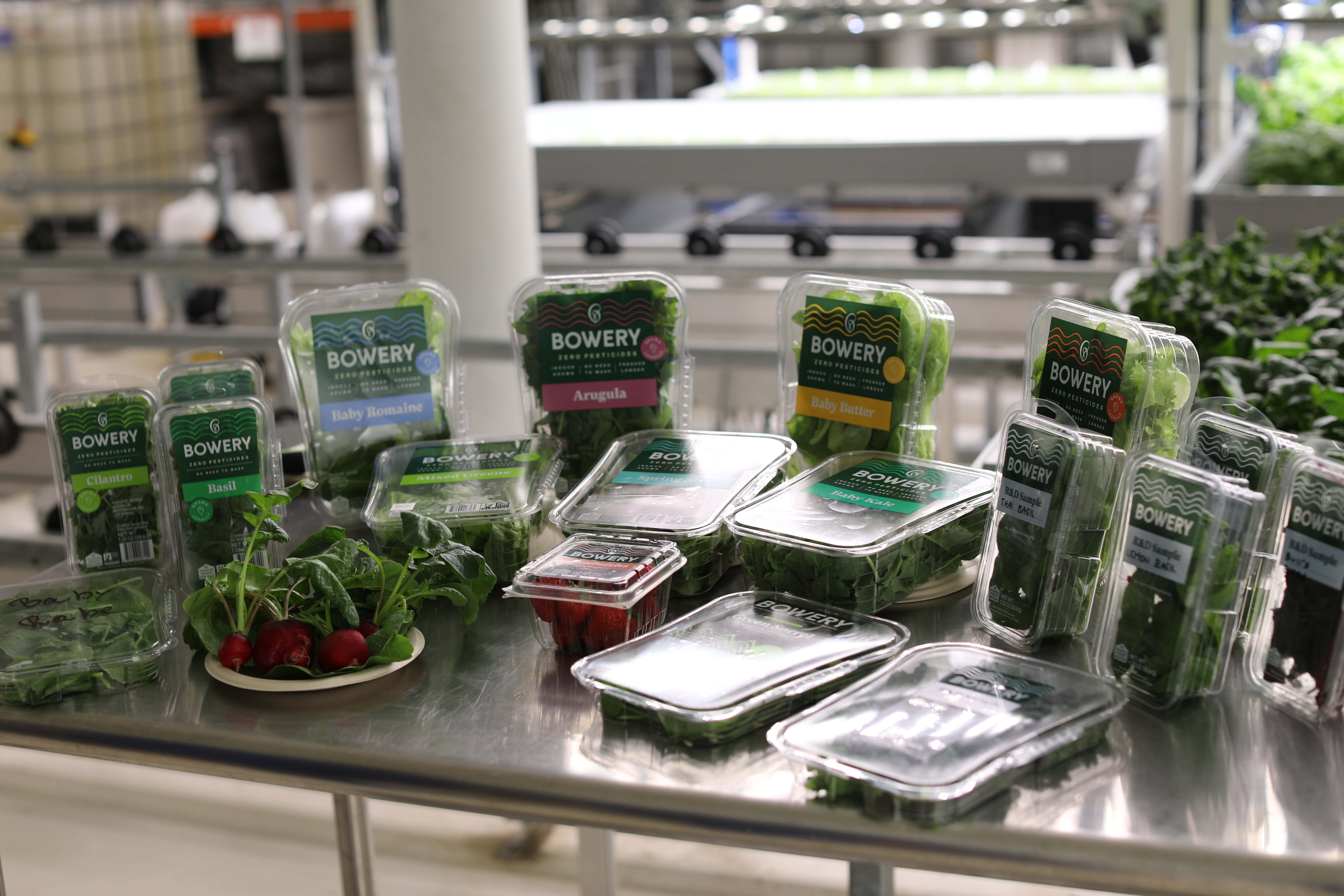
Bowery Farming’s product lineup, with some experimental products. Image Credits: Brian Heater
Years of indoor farming breakthroughs have made it possible for leafy greens to be grown at larger and larger scales — and, eventually, at a profit.
One product the company doesn’t focus on is microgreens, a segment that Bowery’s nearby competitor, AeroFarms, specializes in. Since they’re harvested early in the growing process, immediately after the development of the cotyledon leaves, microgreens have a high turnover. They also fetch a premium in high-end grocery stores, but comprise a relatively small market (I’ll explore Bowery’s finances and competitive landscape further in part four).
Bowery’s crops are grown from standard field seeds, but the tightly controlled nature of its indoor systems affords the company a level of experimentation that would be nearly impossible otherwise. Sztul refers to “stressing” the plants out — depriving them of water or giving them more or less access to inputs like lighting. Every little change can have a profound impact on the flavor profile.
Bowery refers to the sum of these inputs as “recipes,” but these recipes are constantly being tweaked. The intense level of data collection that comes with the growing process means that Bowery can constantly adjust its recipes for efficiency or based on consumer feedback. When Bowery talks about giving back to the vertical farming community, it seems to flirt with the idea of sharing some of its recipes, which are otherwise proprietary.
Which leads back to the arugula with the wasabi kick. Sztul’s eyes light up when I shift the topic to actual wasabi. An expensive and famously difficult crop to grow, the root is nearly impossible to find outside of Japan. In most of the world — the U.S. included — you’re far more likely to be consuming some combination of horseradish, soybean oil, food coloring and, if you’re lucky, a hint of the real stuff.
Could Bowery grow it? “I think it’s definitely possible,” he says, of what has clearly become a pet interest. He’s certainly not alone. University of Iceland students have been experimenting with growing wasabi indoors with hydroponics since at least 2016. The fact that Iceland is the last place you’d think of for growing the plant is precisely the point. The hypercontrolled settings that indoor farming affords helps growers buck most of the seasonal concerns of food crops.
Inside this building, it’s whatever season you want it to be.
High on strawberries
Farm Zero remains an experimental laboratory. You can see, for example, grow trays titled at different angles to test rates of water flow through the crops. But it’s nothing compared to the sorts of experimentation occurring a five-minute walk across the parking lot at Farm X.
This newer building serves as a kind of agricultural skunk works, and if you’re lucky, you’ll go home with produce in an unmarked clamshell with the letters “R&D” scribbled on top in black sharpie.
Farm X is where Bowery focuses on life beyond the leafy green. The company has grown turnips, radishes and peppers within its walls, but none of them are currently available for sale. There are — for now at least — limits to what can be grown at scale indoors, and more to the point, there are limits to what is economically viable. The company likely won’t be putting rice farmers out of business any time soon.
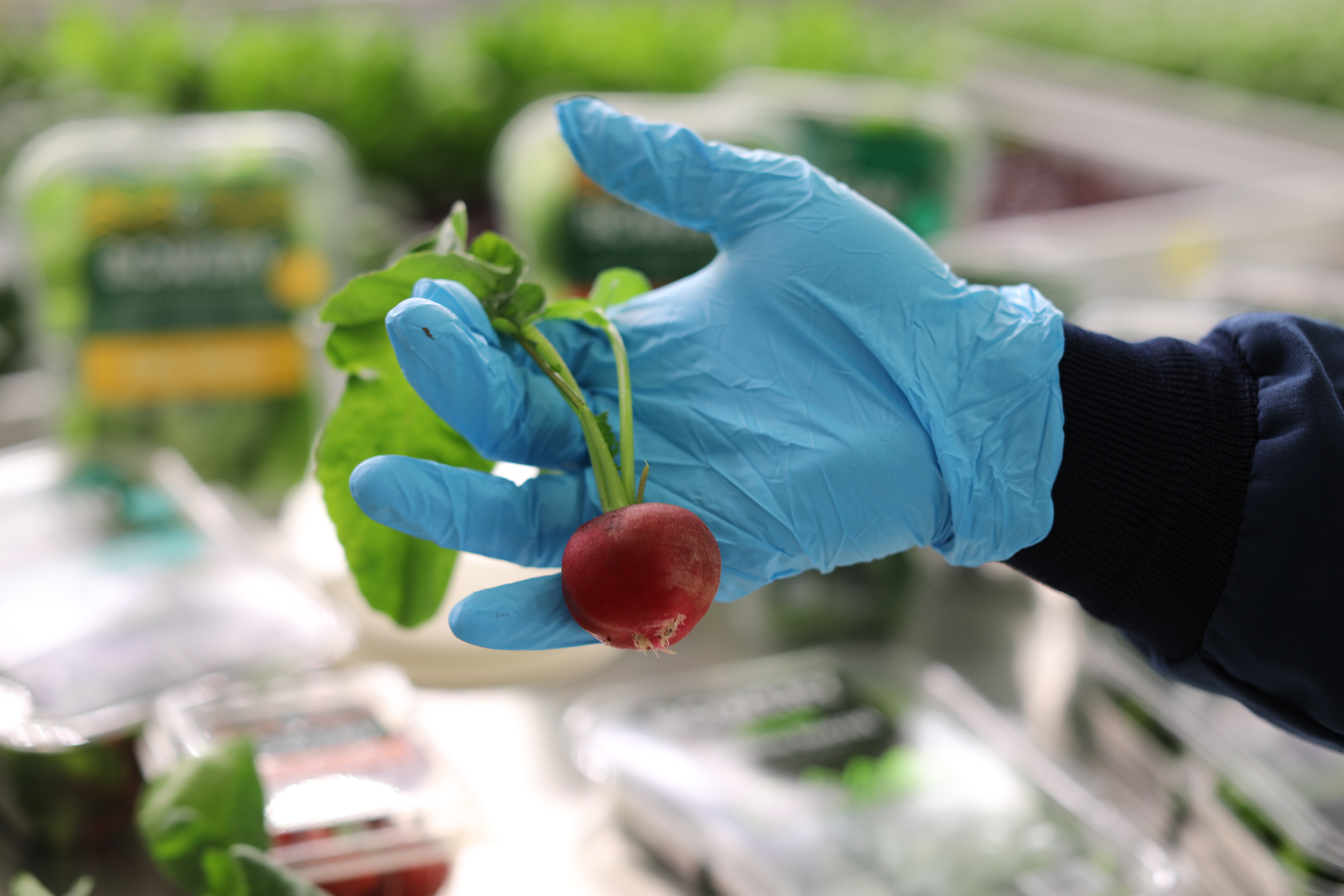
A Bowery Farming turnip. Image Credits: Brian Heater
“Commodity row crops are just done extraordinarily efficiently outdoors today,” says Bowery Farming founder and CEO Irving Fain. “They lend themselves really well to that. Corn, wheat, soy, rice, things like that. But impossible is different, right? Because impossible suggests that it isn’t possible. It very much is possible. I mean, we could build a wheat farm if we wanted to. I don’t think that’s the right economic proposition for us today.”
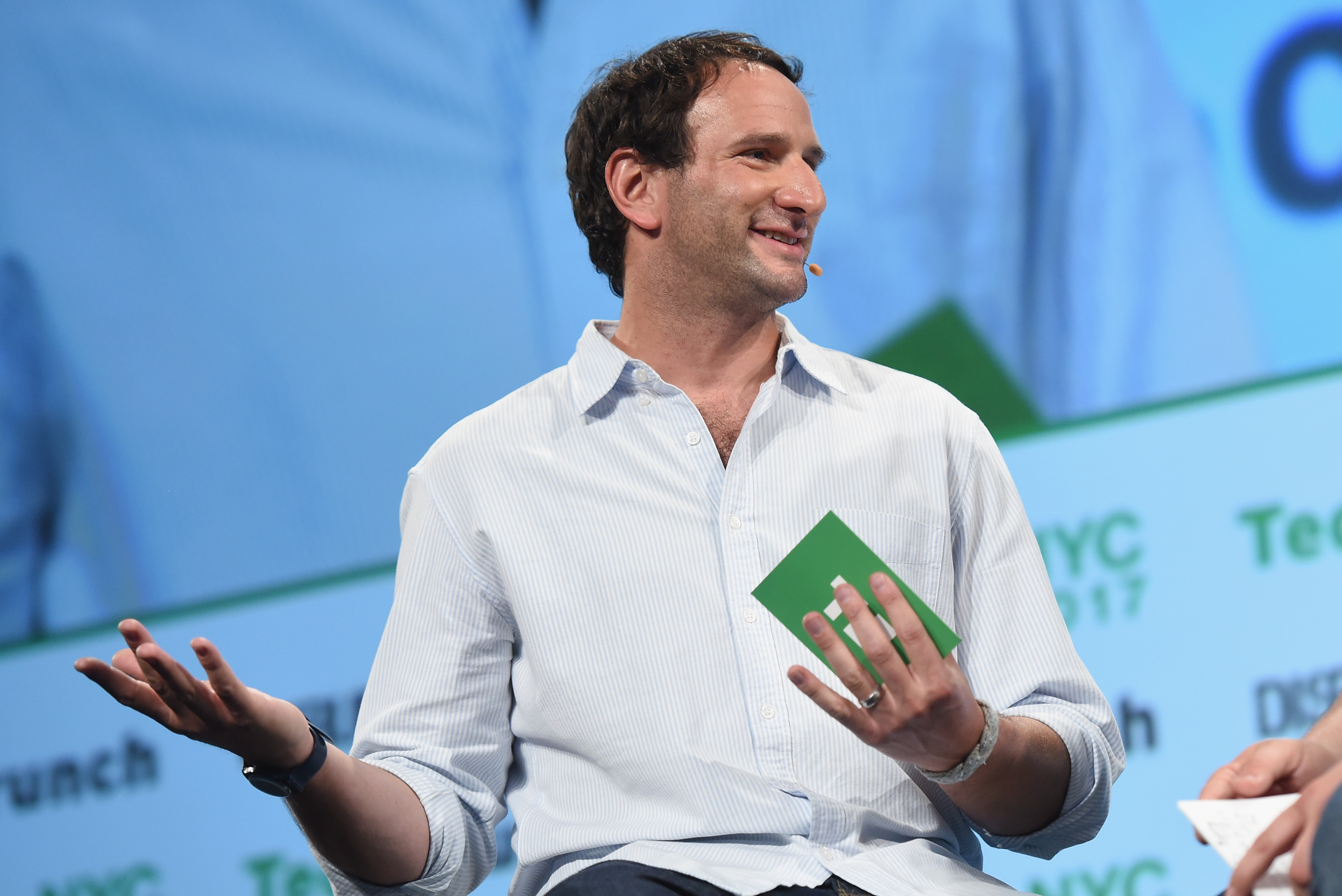
Bowery Farming CEO and founder Irving Fain. Image Credits: Noam Galai/Getty Images for TechCrunch
I turn our conversation to cannabis, which can be efficiently grown indoors for great fun and profit. In fact, marijuana played its own important role in the development of indoor growing, but Fain says it’s not something that interests Bowery.
“I completely respect and understand the folks who are working on it,” he says. “We’re really focused on food and fresh produce, and I think it’s both an important problem and an enormous problem in and of itself. That’s really where our focus is; it’s not moving into cannabis right now.”
Strawberries are, however, currently in the company’s crosshairs. Bowery won’t give me a firm timeline for when its first fruit will arrive on the market, but the ETA for its ETA is “soon.”
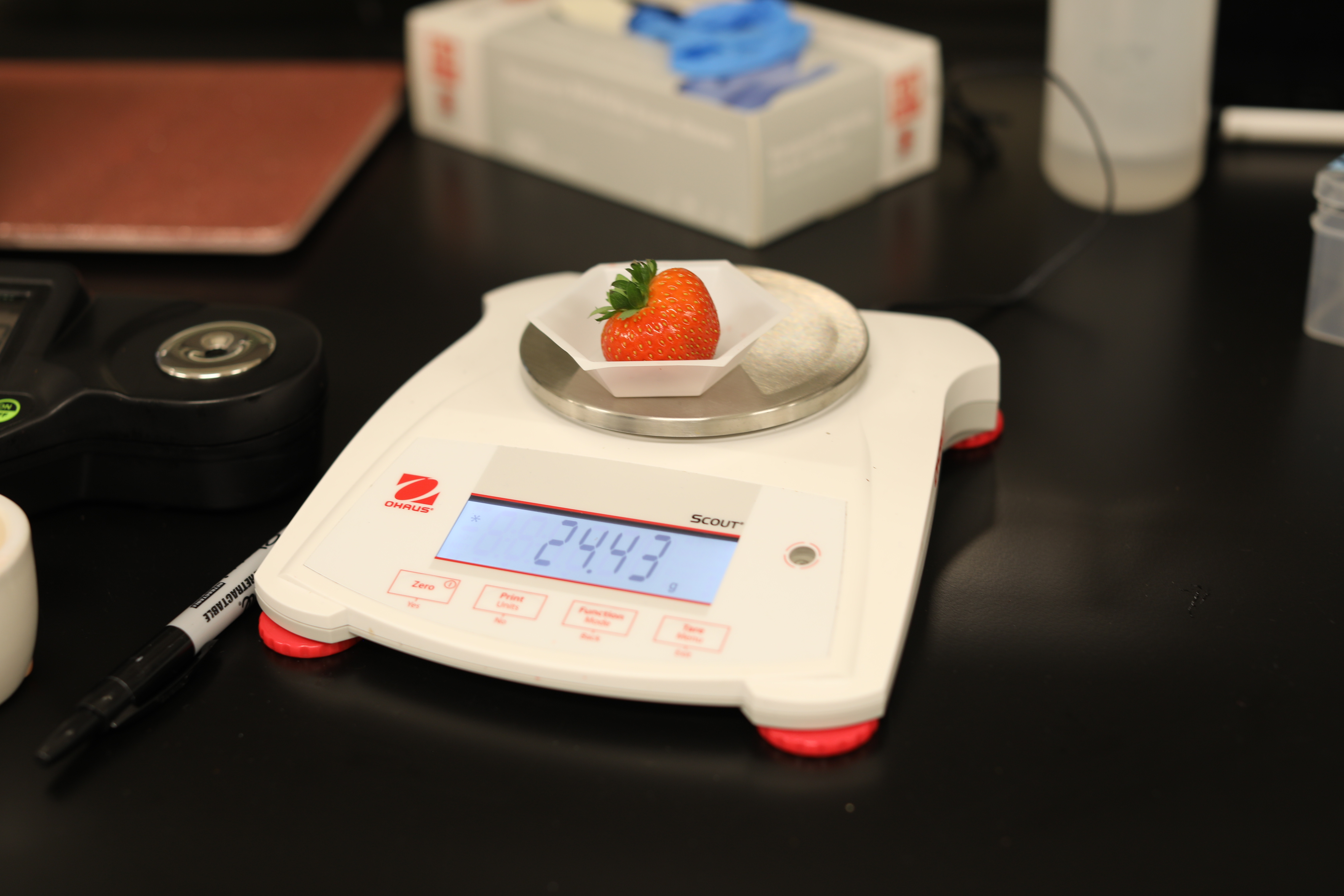
A Bowery Farming strawberry being weighed for size. Image Credits: Brian Heater
In other words, expect an imminent announcement of a timeframe for seeing them at your local supermarket. They’re close enough to production ready that my tour guides lead me into a kind of strawberry experimentation facility. It’s a smaller and sweeter-smelling grow room than the one we were just in at Farm Zero.
The company has been growing strawberries for around two years now, and the results speak for themselves. In a laboratory outside the grow center, employees examine, weigh and catalogue specimens.
The company lines up a handful of berries of varying firmness and sweetness for me. They’re good, but if I’m being honest, there’s still a ways to go before the company can capture the grandeur of the California Central Coast strawberries I grew up on. They do, however, beat a lot of the sorry excuses I’ve bought at my local C-Town after moving out East.
Like the leafy greens before them, the company is experimenting with recipes before bringing the product to market. With strawberries though, you need to add pollination, which can either be performed the traditional way with bees, or by using robotics, which is becoming an increasingly popular option as the global bee population continues to dwindle at a staggering rate.
However, the biggest challenge is scaling.
“How do we go from like Farm Zero, like a smaller scale to really a manufacturing-type scale?” Sztul asks, rhetorically. “That’s the challenge. That’s what we’re focused on solving through different types of engineering both in terms of processing but also growing techniques.”
From rust belt to greenbelt
Heading out from Farm X, we walk to Farm One, the largest of the three buildings on Bowery’s sprawling New Jersey campus. This new farm replaced Farm Zero as the company’s sole on-site production-only facility. Farm One was Bowery’s largest until the November 2019 opening of a new space in Nottingham, Maryland, half an hour outside Baltimore. A third production farm is set to open in Bethlehem, Pennsylvania, early next year.
The New Jersey and Maryland locations are both repurposed logistics centers, while the Pennsylvania farm is set to occupy a 150,000-square-foot former steel mill. The symbolism of new job opportunities created in the shadow of decades-long rustbelt job losses is clear. Bowery’s next farm is set to create 80 new jobs, and while the modern farmer role isn’t the most glamorous in tech, it presents an entry-level opportunity in a growing category.
As we enter Farm One, it’s the lunch rush and dozens of “modern farmers” — Bowery’s name for the staff tasked with harvesting crops — are grabbing meals from a handful of vendors in the lobby.
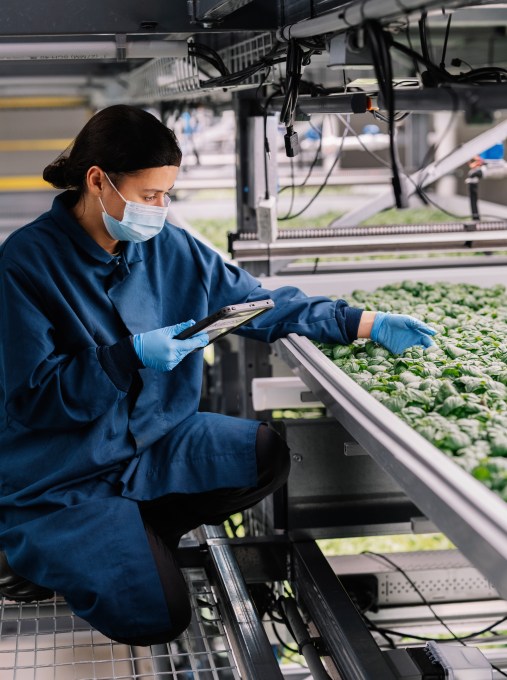
Bowery is creating new “modern farmer” jobs that will bring agricultural labor closer to urban centers. Image Credits: Michael George Photography via Bowery Farming
We walk through the lunch scrum and up the stairs to the second floor for a few final meetings before calling it a day. Past a collection of computers sits a conference room that peers directly into one of Farm One’s four main grow rooms. It’s the best view I’ll get of the inside of this production facility’s farms on my visit — just a sliver, really, but it betrays the difference in scope of the company’s newer facilities.
The view is punctuated by row after row of greenery with a few feet separating the planters. Every so often, a robot whizzes into view to pick up and move a tray, either to a more appropriate location per its recipe or off the grow system and into the care of farmers for harvesting.
“We’re redefining what farming work is, which we’re really excited about,” says Katie Seawell, Bowery’s chief commercial officer, who greets me in the conference room. “We’re bringing it into urban areas or close to urban centers. You can start on day one at Bowery without any experience or knowledge in farming.”
“But we have a structure that looks very much like a manufacturing structure,” she adds. “We have team leaders of the farm who would make sure that each section of the farm is running smoothly, whether that’s processing, packaging [or] growing. And then we have the different shifts that come in and make sure that the farms are actually operating and doing the task that’s signaled by the operating system.”
Once the Pennsylvania location comes online, Bowery says its farms will be able to produce more than 5.5 tons of produce a day, or 20 million shelf-ready clamshells a year — roughly the equivalent output of 5 million square feet of farmland.
In keeping with the vision of vertical farming pioneer Dickson Despommier’s students who we encountered in part one, Bowery’s farms are strategically located next to major metropolitan areas. “Next to” being the key phrase, of course. It’s not quite the vision of food-producing skyscrapers in the middle of city centers that Despommier described in “The Vertical Farm,” but it’s certainly far more localized.
With its vertical farm now horizontally distributing, Bowery Farming has come into its own as a purveyor of greens for a healthy dose of greenbacks. Yet, lettuce is a competitive market, and the company’s first major moat will be its technology and what it dubs “BoweryOS,” the focus of part three of this TC-1.
Bowery Farming TC-1 Table of Contents
- Introduction
- Part 1: Origin story
- Part 2: Produce development
- Part 3: Agtech engineering
- Part 4: Branding, finances and competitive landscape
Also check out other TC-1s on TechCrunch+.
